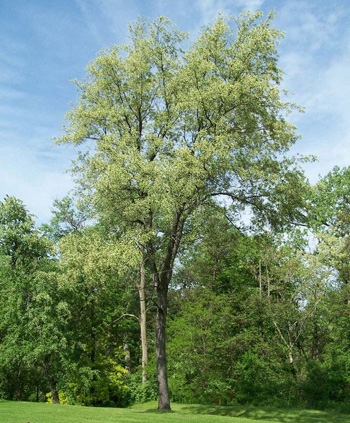Contents:
Common Names | Parts Usually Used | Plant(s) & Culture | Where Found | Medicinal Properties
Legends, Myths and Stories | Uses | Formulas or Dosages | Nutrient Content | How Sold | Warning | Resource Links | Bibliography
Scientific Names
 |
- Prunus serotina L.
- Rosaceae
- Rose family
Common Names
- Ajamoda (Sanskrit name)
- Black cherry
- Black choke
- Caban cherry
- Choke cherry
- Padmaka (Sanskrit name)
- Rub cherry
- Rum cherry
- Virginia prune
- Wild cherry
Parts Usually Used
Dried inner bark. (Leaves and seeds are poisonous)
Back to Top
Description of Plant(s) and Culture
 |
A deciduous tree that grows 40-90 feet tall. The bark is rough, dark gray fissured to expose inner reddish bark beneath. The leaves are oval to lance-shaped, blunt-toothed margins; smooth above, pale beneath, with whitish brown hairs on the prominent midrib. The flowers are in dense drooping slender racemes or spikes, blooms April to June. Fruits are strings of small, juicy cherries, dark red turning black, at times nearly black cherries.
Best known for its highly valued and beautiful wood.
Back to Top
Where Found
Dry woods. Nova Scotia to Florida; Texas to North Dakota; Minnesota.
The cherry tree is a native of Asia and was brought to Italy in the first century BC.
Back to Top
Medicinal Properties
Alterative, astringent, sedative, anti-tussive, digestive, expectorant, carminative, antispasmodic, diuretic
Back to Top
Legends, Myths and Stories
 |
Wild Cherry bark is an aromatic bitter, popular both in the form of a decoction or steeped in whiskey, brandy or wine. As an infusion, the bark should NOT be boiled, as it destroys much of the virtues.
Back to Top
Uses
Aromatic inner bark traditionally used in tea or syrup for coughs, “blood tonic”, fevers, colds, flu, laryngitis, cough, whooping cough, bronchial spasms, bronchitis, sore throats, asthma, high blood pressure, colic, edema, arthritis, diarrhea, lung ailments, eye inflammation, swollen lymph glands, tuberculosis, pneumonia, inflammatory fever diseases, and dyspepsia. Useful for general debility with persistent cough, poor circulation, lack of appetite, mild sedative, and expectorant. Fruits used as “poor man’s” cherry substitute.
Back to Top
Formulas or Dosages
Infusion: steep 1 oz. of the bark in 1 pint of water. Allow to stand over night. Add honey, if desired. Dose: 1/2 wineglassful 3 times a day.
Back to Top
Nutrient Content
Vitamin C
Back to Top
How Sold
Supermarket (fruits)
Back to Top
Warning
Bark, leaves, and seeds contain a cyanide-like glycoside, puransin, which converts (when digested) to the Highly Toxic hydrocyanic acid. Toxins are most abundant in bark harvested in the fall.
Should be used only under medical supervision.
Back to Top
Resource Links
PubMed.gov: Tart cherry juice decreases oxidative stress in healthy older men and women.
Bibliography
![]() Back to Eden
Back to Eden, by Jethro Kloss; Back to Eden Publishing Co., Loma Linda, CA 92354, Original copyright 1939, revised edition 1994
![]() The Herb Book
The Herb Book, by John Lust, Bantam Books, 666 Fifth Avenue, New York, NY. copyright 1974.
![]() The Complete Medicinal Herbal
The Complete Medicinal Herbal, by Penelope Ody, Dorling Kindersley, Inc, 232 Madison Avenue, New York, NY 10016, First American Edition, copyright 1993
![]() Indian Herbalogy of North America
Indian Herbalogy of North America, by Alma R. Hutchens, Shambala Publications, Inc., Horticultural Hall, 300 Massachusetts Avenue, Boston, Massachusetts 02115, 1973
![]() The Herbalist Almanac
The Herbalist Almanac, by Clarence Meyer, Meyerbooks, publisher, PO Box 427, Glenwood, Illinois 60425, copyright 1988, fifth printing, 1994
![]() Culpeper’s Complete Herbal & English Physician: Updated With 117 Modern Herbs
Culpeper’s Complete Herbal & English Physician: Updated With 117 Modern Herbs, by Nicholas Culpeper, Meyerbooks, publisher, PO Box 427, Glenwood, Illinois 60425, 1990, (reprint of 1814)
![]() Eastern/Central Medicinal Plants
Eastern/Central Medicinal Plants, by Steven Foster and James A. Duke., Houghton Mifflin Company, 215 Park Avenue South, New York, NY 10000
 An Instant Guide to Medicinal Plants
An Instant Guide to Medicinal Plants, by Pamela Forey and Ruth Lindsay, Crescent Books (January 27, 1992).
 Old Ways Rediscovered
Old Ways Rediscovered, by Clarence Meyer, Meyerbooks, publisher, PO Box 427, Glenwood, Illinois 60425, published from 1954, print 1988
![]() The Yoga of Herbs: An Ayurvedic Guide to Herbal Medicine
The Yoga of Herbs: An Ayurvedic Guide to Herbal Medicine, by Dr. David Frawley & Dr. Vasant Lad, Lotus Press, Twin Lakes, Wisconsin, Second edition, 1988.
 How Indians Use Wild Plants for Food, Medicine & Crafts
How Indians Use Wild Plants for Food, Medicine & Crafts, by Frances Densmore, Dover Publications, Inc., 180 Varick Street, New York, NY 10014, first printed by the United States Government Printing Office, Washington, in 1928, this Dover edition 1974
![]() American Folk Medicine
American Folk Medicine, by Clarence Meyer, Meyerbooks, publisher, PO Box 427, Glenwood, Illinois 60425, 1973
